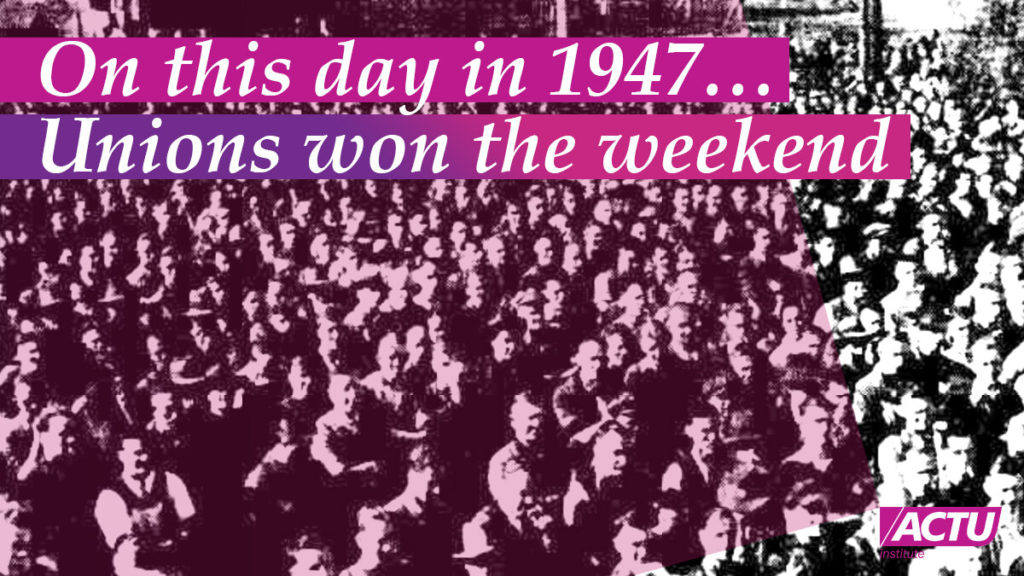
Did you know that workers in their unions had to take action to win the weekend?
On 8 September 1947 a long union campaign to reduce the working week to 40 hours was victorious. On that day, the Arbitration Court ruled that from 1 January 1948 the 40-hour, five day, working week would begin, with two days off from work.
This was the start of the weekend!
And this is the story of how workers came together in their unions, took actions, and won this important right.

The story begins in April of 1856 at a very unlikely place for workers’ struggle – the University of Melbourne.
On the 21st of April 1856, on a stinking hot day, Stonemasons working at the university walked off the job demanding the eight-hour day. It was typical at this time for workers to toil ten hours a day (or more), six-days a week.
Employers were aghast at this action – how were they going to make profit if workers only worked for eight hours a day?
But the Stonemasons insisted that workers had a right to decent rest and recreation. Our lives, they argued, should not just be about the work we do.

We have a right to a life outside of work, a right to a work/life balance.
Whether it be going to the footy, spending time with family, assembling in a place of worship, or just spending hours binging something on Netflix (ok, that is probably not something the Stonemasons said, but you get the idea).
We have the right to decide what to do with OUR lives.
The Stonemasons marched down from Melbourne Uni to the Parliament House which was being built. Builders on this site also took strike action.

And together these workers won the eight-hour day.
It was the first time anywhere in the world workers had won the eight-hour day with no loss of pay across an industry.
It sent a clear message: workers have the right to a life outside of the workplace.
During the First World War the dangerous and difficult work led to the 44-hour week being introduced in some industries.
But some employers and conservative politicians hated this.
When the Arbitration Court awarded the 44-hour week to engineers and timber workers in 1920, the Federal Government brought in laws to stop it – even going so far as to change the composition of the court itself!
Some employers discriminated against those unionists who tried to enforce their right to the 44-hour week, and successfully applied to the new court to increase hours back to 48 a week.

It was not until 1939 union campaigning led to the 44-hour week become standard across industries.
So, in 1941, working five and a half days a week – half of Saturday – was a SHORT working week.
From 1939 to 1945 Australia was at war. And unions played our part by not pushing for certain wage rises and better conditions that we ordinarily would so we could help the war effort.
But after the war the workers who had sacrificed so much sought to gain the better conditions we deserved.
This included a big push for the 40 hour week.

There were a large number of strikes at this time, building pressure for change.

The ACTU prepared a case to put before the Arbitration Court.
We were opposed by employer groups who absolutely insisted it would be devastating for business if workers only worked for 40 hours a week.

The President of the Chamber of Manufacturers called it an
“unnecessary and dangerous experiment”.
One of the high-priced lawyers hired by big business who pushed the argument against the union movement said…
“…the ACTU case in favour of the 40-hour week had been based largely on sentimental philosophical considerations”
What were these considerations?
Unions made the case that working people are not just workers – we are people! We have a right to a life outside of work.
The ACTU’s argument was ultimately accepted.
In 1947 the Arbitration Court decided in favour of the 40-hour week, which would be implemented as a general standard from 1 January 1948. The weekend was born!
But that wasn’t the end.
In the years that followed unions won major victories that protected our right to a life outside of the workplace.
We extended the right to annual leave to three weeks, and then to four.
In 1981 the Metal Workers won the right to the 38 hour week. This soon was applied to other industries as well.

But today these victories are under threat and for too many workers these rights are historic.
For many casual workers and for workers in the gig economy, there is no such thing as a weekend.
Even the penalty rates that unions won for casual workers have been taken away in many industries.
And even though unions campaigned tooth and nail against this – our opponents were successful.
Why is this?
The biggest lesson from the history of the weekend is a simple one: these victories have come when workers get organised in their unions and take action.
In recent decades unions have been under attack. Employers and governments have taken action to make jobs less secure.

It is no surprise that when unions have been attacked the rights we have won have been taken away.
We can’t let big business and conservative politicians take us back to the 19th century.
Unions want a new future, a better future, for all working people. A future where we can contribute meaningfully at work – but also enjoy our lives outside of work.
This means we need more unionists taking action for secure work.
The best way to help make that better future a reality is to join your union.



